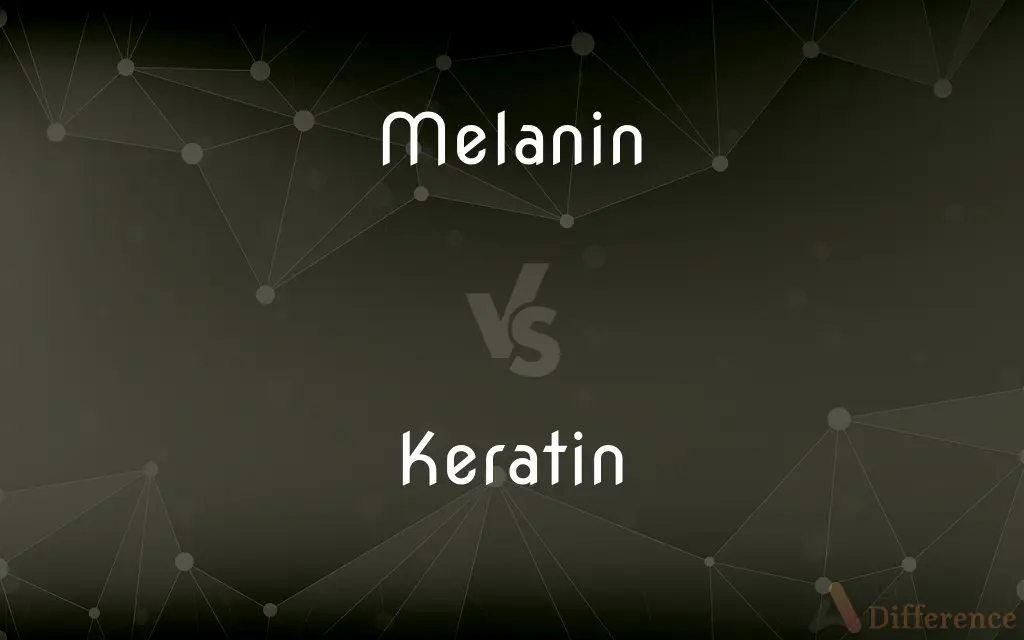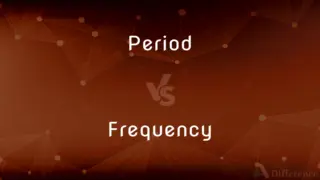Melanin vs. Keratin — What's the Difference?
By Fiza Rafique & Urooj Arif — Updated on April 29, 2024
Melanin is a pigment that colors skin, hair, and eyes, playing a role in UV protection, while keratin is a protein that strengthens hair, skin, and nails, providing structural support and protection.

Difference Between Melanin and Keratin
Table of Contents
ADVERTISEMENT
Key Differences
Melanin is primarily responsible for the coloration in skin, hair, and eyes, helping to protect cells from UV radiation damage. On the other hand, keratin is a structural protein that strengthens and protects the cells of hair, skin, and nails from physical and chemical damage.
While melanin affects the color and can protect against sunburn by absorbing harmful UV rays, keratin provides the rigidity and resilience necessary for the outer layers of skin, as well as hair and nails, preventing injury and wear. Whereas melanin's role is protective in a more biochemical sense against sunlight.
In terms of production, melanin is synthesized from the amino acid tyrosine in specialized cells called melanocytes. Conversely, keratin is produced by keratinocytes and is a key component of the epidermal layer of the skin, showing how each component is vital but distinct in tissue function and health.
The distribution of melanin can lead to variations in skin, hair, and eye color among different individuals and races, highlighting its role in biological diversity. On the other hand, keratin’s presence and structure are fairly consistent across all humans, but its health can greatly affect the appearance and function of skin and hair.
While both melanin and keratin are essential for the protection and proper functioning of the body, they operate through distinctly different mechanisms and serve diverse biological roles.
ADVERTISEMENT
Comparison Chart
Function
Pigmentation and UV protection
Structural support and protection
Found in
Skin, hair, eyes
Skin, hair, nails
Primary Role
Coloration and sun protection
Strength and resilience
Production Site
Melanocytes
Keratinocytes
Chemical Nature
Pigment
Protein
Impact on Appearance
Determines color diversity
Affects texture and strength
Compare with Definitions
Melanin
Helps in protecting the skin from UV radiation.
Higher melanin levels are associated with lower risks of sunburn and skin cancers.
Keratin
A fibrous protein that forms the structural component of hair, nails, and the outer layer of skin.
Keratin treatments are used to smooth and shine hair.
Melanin
A natural pigment found in most organisms, responsible for color in skin, hair, and eyes.
Melanin provides darker skin tones with more protection against UV rays.
Keratin
Essential for the protective quality of skin and hair.
Keratin layers help skin resist abrasion and water damage.
Melanin
Varies widely among different ethnic groups.
Melanin levels are typically higher in populations closer to the equator.
Keratin
Produced in skin cells called keratinocytes.
Damaged keratinocytes can lead to skin conditions like psoriasis.
Melanin
Influences the aesthetic and functional characteristics of an organism.
Melanin in the iris determines eye color.
Keratin
Provides strength and rigidity to cells it composes.
Nails are hard and protective due to their high keratin content.
Melanin
Produced in cells known as melanocytes.
People with albinism have melanocytes that do not produce melanin effectively.
Keratin
Varies in composition to suit different functions in the body.
Hard keratin in nails and soft keratin in skin.
Melanin
Melanin ( (listen); from Greek: μέλας melas, "black, dark") is a broad term for a group of natural pigments found in most organisms. Melanin is produced through a multistage chemical process known as melanogenesis, where the oxidation of the amino acid tyrosine is followed by polymerization.
Keratin
Keratin () is one of a family of fibrous structural proteins known as scleroproteins. α-Keratin is a type of keratin found in vertebrates.
Melanin
A dark brown to black pigment occurring in the hair, skin, and iris of the eye in people and animals. It is responsible for tanning of skin exposed to sunlight.
Keratin
A fibrous protein forming the main structural constituent of hair, feathers, hoofs, claws, horns, etc.
Melanin
Any of a group of naturally occurring dark pigments, especially the pigment found in skin, hair, fur, and feathers.
Keratin
Any of a class of filamentous proteins that are abundant in the cytoskeleton of vertebrate epithelial cells and are the main constituents of the outer layer of skin and tough epidermal structures such as hair, nails, hooves, feathers, and claws.
Melanin
(biochemistry) Any of a group of naturally occurring dark pigments, especially the pigment found in skin, hair, fur, and feathers.
Keratin
Material composed principally of keratin proteins.
Melanin
A black pigment found in the pigment-bearing cells of the skin (particularly in the skin of the negro), in the epithelial cells of the external layer of the retina (then called fuscin), in the outer layer of the choroid, and elsewhere. It is supposed to be derived from the decomposition of hemoglobin.
Keratin
(protein) The protein of which hair and nails are composed.
Melanin
Insoluble pigments that account for the color of e.g. skin and scales and feathers
Keratin
A sulfur-containing fibrous protein constituting the main structural protein of hard epidermal tissues, such as horn, hair, feathers, nails, claws, hoofs, and the like. It is an insoluble substance, and, unlike elastin, is not dissolved even by gastric or pancreatic juice. By decomposition with sulphuric acid it yields leucine and tyrosine plus various other acid-stable amino acids. The amino acid composition varies, but it usually has a high percentage of cystine, which stabilizes and insolubilizes the protein by forming intrachain linkages. A softer form of keratin is present in the epidermis and whalebone. Called also epidermose.
Keratin
A fibrous scleroprotein that occurs in the outer layer of the skin and in horny tissues such as hair feathers nails and hooves
Common Curiosities
What is the primary difference between melanin and keratin?
Melanin is a pigment that provides color and UV protection, whereas keratin is a protein that provides structural strength to hair, skin, and nails.
Why do some people have more melanin than others?
Genetic factors primarily determine melanin levels, influencing skin, hair, and eye color based on ancestral geographic locations.
How do melanin and keratin work together in the skin?
Melanin protects the skin from UV damage, while keratin strengthens the skin and makes it resistant to physical damage.
How does UV exposure affect melanin and keratin?
UV exposure increases melanin production to protect against UV damage but can break down keratin, damaging hair and skin.
What happens if you have too much or too little keratin?
Too much keratin can lead to conditions like keratosis pilaris (rough, bumpy skin), while too little can make hair, skin, and nails weak and brittle.
What dietary choices support healthy melanin and keratin levels?
A diet rich in antioxidants can support melanin production, while proteins and biotin are important for keratin.
Can you increase the production of melanin or keratin?
Melanin production can be increased by sun exposure, though it's risky; keratin production can be supported with a diet rich in protein and vitamins.
How does aging affect melanin and keratin production?
Aging can reduce the production of both melanin and keratin, leading to graying hair, less effective UV protection, and weaker skin and nails.
Is there any relationship between keratin and hair treatments?
Yes, keratin treatments are used to smooth and strengthen hair by temporarily replenishing the hair's natural keratin content.
Are there health conditions associated with defects in melanin or keratin?
Yes, conditions like albinism result from defects in melanin production, while disorders like keratosis pilaris involve excess keratin buildup.
How are melanin and keratin analyzed in scientific research?
Researchers study melanin and keratin to understand their roles in diseases, genetics, and body functions.
Can keratin be found in animals other than humans?
Yes, keratin is a key component in feathers, hooves, and horns of various animals.
What role does melanin play in eye color?
Melanin concentration in the iris determines whether eyes are light or dark colored.
What evolutionary advantage does melanin provide?
Melanin provides a protective advantage against sun damage, which can lead to skin cancer, benefiting long-term survival.
Are there synthetic forms of melanin or keratin used in industry?
Synthetic melanin is used in materials science, while synthetic keratin is used in cosmetics and hair care products.
Share Your Discovery

Previous Comparison
Period vs. Frequency
Next Comparison
Beethoven vs. MozartAuthor Spotlight
Written by
Fiza RafiqueFiza Rafique is a skilled content writer at AskDifference.com, where she meticulously refines and enhances written pieces. Drawing from her vast editorial expertise, Fiza ensures clarity, accuracy, and precision in every article. Passionate about language, she continually seeks to elevate the quality of content for readers worldwide.
Co-written by
Urooj ArifUrooj is a skilled content writer at Ask Difference, known for her exceptional ability to simplify complex topics into engaging and informative content. With a passion for research and a flair for clear, concise writing, she consistently delivers articles that resonate with our diverse audience.
















































